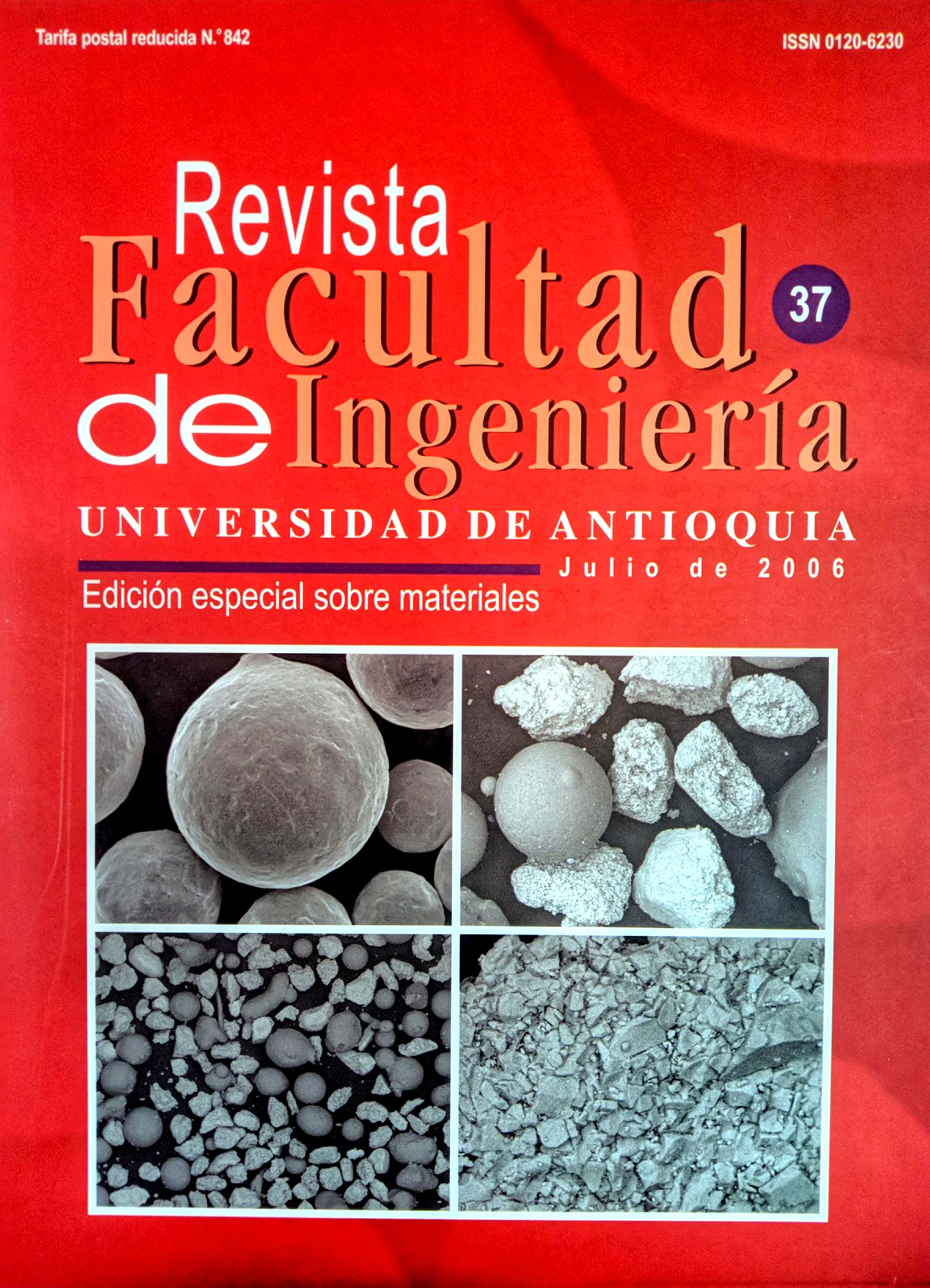Obtención de un material carbonáceo activado de antracita para posibles aplicaciones en hidrometalurgia
DOI:
https://doi.org/10.17533/udea.redin.343392Palabras clave:
carbón activado, antracita, activación, adsorciónResumen
En este trabajo se obtuvo carbón activado a partir de una antracita proveniente del Páramo del Almorzadero (municipio de Cerrito, Santander), con un 96,6% de carbono fijo; se analizó la antracita y se trató en dos etapas, una de activación química con ácidos para incrementar la reactividad de la superficie externa y facilitar el acceso a la superficie interna del carbón, y otra de activación física a temperaturas de 800, 1.000 y 1.200 oC con CO2. Se evaluó el efecto de las variables del proceso de activación sobre la actividad del carbón y se hallaron las mejores condiciones para lograr un producto con las mejores características, se obtuvo una superficie específica del carbón activado de 107,4 m2/g. Se analizó su utilización en hidrometalúrgia, específicamente en la recuperación de oro donde se obtuvo una capacidad de adsorción de oro de 6,6 kg/toneladas de carbón activado.
Descargas
Citas
C. Daulan. “Influence of anthracite pretreatment in the preparation of activated carbons”. Fuel. 1998. pp. 495-502. DOI: https://doi.org/10.1016/S0016-2361(97)00202-0
T. Budinova, N. Petrov “Influence of thermooxidate treatment on the surface properties of anthracite”. Fuel. 1998. pp. 577-580. DOI: https://doi.org/10.1016/S0016-2361(97)00141-5
R. Lyubchik , F. Benoit, F. Beguin. “Influence of chemical modification of anthracite on the porosity”. Carbon. Vol. 40. 2002. pp. 1287-1294.
J. L. Cortina, R. M. Kautzmann, R. Gliese, C. H. Sampaio. “Extraction studies of aurocyanide using Macronet adsorbents: physico-chemical characterization”. Reactive & Functional Polymers. Vol. 60. 2004.pp. 97-107. DOI: https://doi.org/10.1016/j.reactfunctpolym.2004.02.015
C.Andresen, E. Burgess. “New directions for non-fuel uses of anthracites” Fuel Processing Technology. Vol. 85. 2004. pp.1373-1392. DOI: https://doi.org/10.1016/S0378-3820(03)00206-6
A. Aworn, P. Thiravetyan, W. Nakbanpote. “Recovery of gold from gold slag by wood shaving fly ash”. Journal of Colloid and Interface Science. Vol. 287. 2005. pp.394-400. DOI: https://doi.org/10.1016/j.jcis.2005.02.048
O. Lozano, C. Linares. “Preparation of activated carbons from Spanish anthracite” Carbon Vol. 39. 2001. pp. 751-759. DOI: https://doi.org/10.1016/S0008-6223(00)00186-X
M. M. Maroto-Valer, Z. Tang, Y. Zhang “CO2 capture by activated and impregnated anthracites”. Fuel Processing Technology, en prensa. 2005. DOI: https://doi.org/10.1016/j.fuproc.2005.01.003
S. B. Lyubchik, R. Benoit, F. Béguin. “Influence of chemical modification of anthracite on the porosity of the resulting activated carbons”. Carbon. Vol. 40. 2002. pp. 1287-1294. DOI: https://doi.org/10.1016/S0008-6223(01)00288-3
S. B. Lyubchik, L. Ya. Galushko, A. M. Rego, Yu. V. Tamarkina, O. L. Galushko, I. M. Fonseca. “Intercalation as an approach to the activated carbon preparation from Ukrainian anthracites”. Journal of Physics and Chemistry of Solids. Vol. 65. 2004. pp. 127-132. DOI: https://doi.org/10.1016/j.jpcs.2003.10.006
A. Perrin, A. Celzard, A. Albiniak, M. Jasienko-Halat, J. F. Marêché and G. Furdin “NaOH activation of anthracites: effect of temperature on pore textures and methane storage ability”. Carbon. Vol. 42. 2004. pp. 2855-2866. DOI: https://doi.org/10.1016/j.carbon.2004.06.030
Suggatea, Dickinsonb. “Carbon NMR of coals: the effects of coal type and rank”. International Journal of Coal Geology. Vol. 57. 2004. pp. 1-22. DOI: https://doi.org/10.1016/S0166-5162(03)00116-2
http:/www.MINTEK.ACZA/emd/CIP/cip; the carbon in pulp process. 2000. Consultada en diciembre, 2004.
Descargas
Publicado
Cómo citar
Número
Sección
Licencia
Los artículos disponibles en la Revista Facultad de Ingeniería, Universidad de Antioquia están bajo la licencia Creative Commons Attribution BY-NC-SA 4.0.
Eres libre de:
Compartir — copiar y redistribuir el material en cualquier medio o formato
Adaptar : remezclar, transformar y construir sobre el material.
Bajo los siguientes términos:
Reconocimiento : debe otorgar el crédito correspondiente , proporcionar un enlace a la licencia e indicar si se realizaron cambios . Puede hacerlo de cualquier manera razonable, pero no de ninguna manera que sugiera que el licenciante lo respalda a usted o su uso.
No comercial : no puede utilizar el material con fines comerciales .
Compartir igual : si remezcla, transforma o construye a partir del material, debe distribuir sus contribuciones bajo la misma licencia que el original.
El material publicado por la revista puede ser distribuido, copiado y exhibido por terceros si se dan los respectivos créditos a la revista, sin ningún costo. No se puede obtener ningún beneficio comercial y las obras derivadas tienen que estar bajo los mismos términos de licencia que el trabajo original.










 Twitter
Twitter